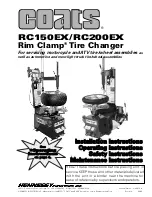
Important: Always read and follow the operating instructions.
• 5
5a.
Prior to placing the wheel on the table top to
clamp, observe the style and strength of the wheel
and adjust the clamp pressure as necessary using the
pressure regulator and gauge. Thin spun aluminum
rims sometimes used on ATV and motorcycle are
sometimes delicate and a reduced air pressure should
be considered verses cast aluminum and steel wheels
that can support more clamping force.
5b.
Next, observe the rim size from the tire, ie. 15,
16, 17, etc. Using the clamp pedal, place the clamp
valve in the JOG IN position for prelocating the clamps
to the rim diameter. Accomplish this by moving the
pedal from the UP position to the 1/2-DOWN location.
Then JOG the pedal DOWN allowing the clamps to
move inward until the pointer on the clamps align with
the rim diameter on the table top decal. It may be nec-
essary to relocate the clamps on the clamp carriers.
Each clamp should be in the same position before pre-
locating the clamps.
5c.
Determine the mounting side of the wheel. The
mounting side is the narrow side of the drop center.
(Tire removed in Figure 4 for clarity.)
Figure 4 - Determining Mounting Side of Wheel (Note that
many motorcycle rims are symmetrical)
6.
Place tire/wheel assembly on table top with
mounting side up (Figure 5). Use the clamp control
pedal to move the clamps inward (push pedal down).
Clamp motorcycle and ATV wheels from the outside
(clamps push inward against the outside rim edge).
Observe closely to prevent tire/wheel damage.
Note:
On motorcycle machines, the clamps move
slower than on automotive machines.
Figure 5 - Place Tire/Wheel Assembly on Table Top
7.
Move the swing arm into position. Pull the locking
handle forward to release the slide. Push down on the
top of the vertical slide to move the demount head into
contact with the rim edge. Push the locking handle
back to lock the slide into place. As the slide is locked,
the mount/demount head will move upward approxi-
mately 1/8 inch from the rim edge.
Note:
On plastic duck-
heads, the upward move-
ment should be limited to
1/16-inch maximum.
Figure 6 - Position Mount/Demount Tool
8.
The duckhead
®
roller should be in contact with the
rim edge. Turn the swing arm adjusting knob to move
the head away from the rim 1/8 to 1/4-inch. On expen-
sive and polished rims, it is recommended a plastic
bootie (p/n 8183373) be used over the duckhead roller.
Figure 7 - Adjust Swing Arm to Position Head Roller
9.
Check head positioning. Duckhead
®
should be
positioned with 1/8 to 3/16-inch clearance between the
top of the rim edge and the bottom of the head (with
plastic duckhead it is recommended the vertical clear-
ance be limited to a maximum of 1/16-inch) and 1/8 to
1/4-inch clearance between the rim edge and the head.
This clearance will be maintained as long as the lock-
ing handle and adjustment knob are not changed. The
operator may swing the arm out of the way and back
into place again without needing to reposition the head
(when changing a set of the same wheels).
Figure 8 - Proper Mount/Demount Head Position
Motorcycle
ATV
Narrow Side
Long Side
Drop Center
Motorcycle
ATV
1/8" to 1/4"
1/8" to 3/16"





























